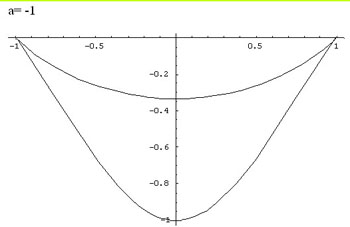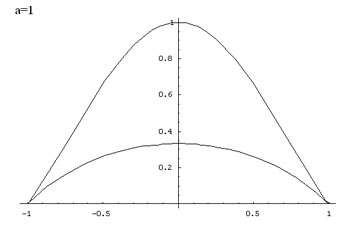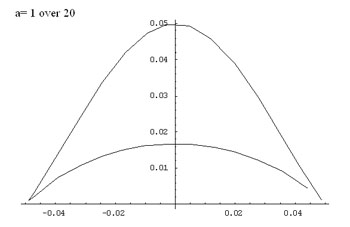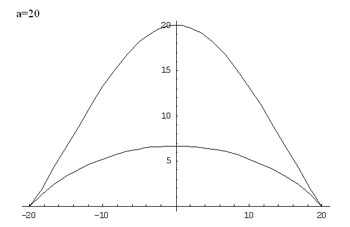Copyright © University of Cambridge. All rights reserved.
'Cocked Hat' printed from https://nrich.maths.org/
Show menu
| Congratulations Aleksander from Gdynia Bilingual High School No3, Poland for your excellent solution to the Cocked Hat problem. As you will see, the solution hinges on simplification of an algebraic expression and solving a quadratic equation. |
Here is Aleksander's
solution.
First we will rearrange the expression from implicit to
explicit form. The given equation is
$$(x^2 + 2ay -a^2)^2 = y^2(a^2 - x^2)$$
Squaring the LHS gives
$$4a^2y^2 + 4ay(x^2-a^2) + (x^2 - a^2)^2 = y^2(a^2 -
x^2).$$
Collecting like terms gives the quadratic equation
$$y^2(3a^2+x^2)+ 4ay(x^2-a^2) + (x^2 - a^2)^2 = 0.$$
The discriminant is
$$\Delta = {16a^2(x^2 - a^2)^2-4(3a^2+x^2)(x^2-a^2)^2}= (x^2 -
a^2)^2(4a^2-x^2) = 4(a^2 - x^2)^3.$$
Solving this equation we get:
$$\eqalign{ y &= {-4a(x^2 - a^2)\pm \sqrt{4(a^2 -
x^2)^3}\over 2(3a^2+x^2)} \cr &= {(x^2-a^2)(-2a\pm
\sqrt{(a^2-x^2)})\over (3a^2+x^2)} }$$
For each value of $a$ there are two branches of the graph
given by taking the +ve and -ve signs in this equation. Values of
$y$ are only defined for the interval $-a \leq x \leq a$. The
domain of $f(x)$ is $-a \leq x \leq a.$ The zeros of the function
are given by $x = a$ and $x = -a.$
Additionally, the function is symmetric with respect to the
y-axis, because $x$ always appears in even powers. Graphs for
parameters $a = n$ and $a = -n$ and are symmetric to each other
with respect to the x-axis, that is $y(n) = y(-n)$. Proof:
$$ {(x^2-n^2)(-2n\pm \sqrt{(n^2-x^2)})\over (3n^2+x^2)} =
-{(x^2-(-n)^2)(-2(-n)\pm \sqrt{(-(n)^2-x^2)})\over
(3(-n)^2+x^2)}$$
Here are some graphs of the function:
 |
 |
 |
 |